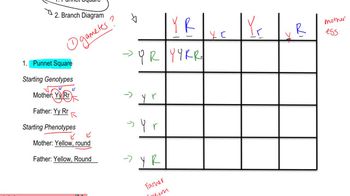Table of contents
- 1. Introduction to Genetics51m
- 2. Mendel's Laws of Inheritance3h 37m
- 3. Extensions to Mendelian Inheritance2h 41m
- 4. Genetic Mapping and Linkage2h 28m
- 5. Genetics of Bacteria and Viruses1h 21m
- 6. Chromosomal Variation1h 48m
- 7. DNA and Chromosome Structure56m
- 8. DNA Replication1h 10m
- 9. Mitosis and Meiosis1h 34m
- 10. Transcription1h 0m
- 11. Translation58m
- 12. Gene Regulation in Prokaryotes1h 19m
- 13. Gene Regulation in Eukaryotes44m
- 14. Genetic Control of Development44m
- 15. Genomes and Genomics1h 50m
- 16. Transposable Elements47m
- 17. Mutation, Repair, and Recombination1h 6m
- 18. Molecular Genetic Tools19m
- 19. Cancer Genetics29m
- 20. Quantitative Genetics1h 26m
- 21. Population Genetics50m
- 22. Evolutionary Genetics29m
2. Mendel's Laws of Inheritance
Dihybrid Cross
Problem 8b
Textbook Question
Determine whether the statements below are true or false. If a statement is false, provide the correct information or revise the statement to make it correct.
If a dihybrid plant is self-fertilized,
(1) 9/16 of the progeny will have the same phenotype as the F₁ parent.
(2) 1/16 of the progeny will be true-breeding.
(3) 1/2 of the progeny will be heterozygous at one or both loci.
 Verified step by step guidance
Verified step by step guidance1
Step 1: Understand the concept of a dihybrid cross, which involves two traits, each with two alleles. The F1 generation is typically heterozygous for both traits (e.g., AaBb).
Step 2: Use a Punnett square to determine the genotypic and phenotypic ratios of the F2 generation when a dihybrid plant (AaBb) is self-fertilized. This involves a 4x4 grid representing all possible combinations of alleles.
Step 3: Calculate the phenotypic ratio for the F2 generation. The typical ratio for a dihybrid cross is 9:3:3:1, where 9/16 of the progeny exhibit the dominant phenotype for both traits.
Step 4: Identify the true-breeding progeny. True-breeding individuals are homozygous for both traits (e.g., AABB, aabb). Calculate the proportion of these genotypes in the F2 generation.
Step 5: Determine the proportion of progeny that are heterozygous at one or both loci. This involves identifying genotypes such as AaBb, Aabb, aaBb, and others that include at least one heterozygous locus.
Recommended similar problem, with video answer:
 Verified Solution
Verified SolutionThis video solution was recommended by our tutors as helpful for the problem above
Video duration:
5mPlay a video:
Was this helpful?
Key Concepts
Here are the essential concepts you must grasp in order to answer the question correctly.
Dihybrid Cross
A dihybrid cross involves two traits, each represented by two alleles. In Mendelian genetics, when two heterozygous individuals (e.g., AaBb x AaBb) are crossed, the expected phenotypic ratio of the offspring is 9:3:3:1. This ratio reflects the independent assortment of alleles for the two traits, which is a fundamental principle of inheritance.
Recommended video:
Guided course

Punnet Square
Phenotypic Ratio
The phenotypic ratio describes the relative frequencies of different phenotypes in the offspring of a genetic cross. In a dihybrid cross, the expected ratio of phenotypes is 9:3:3:1, where 9 represents the dominant phenotype for both traits. Understanding this ratio is crucial for evaluating statements about the progeny of a dihybrid self-fertilization.
Recommended video:
Guided course

Mutations and Phenotypes
True-Breeding and Heterozygosity
True-breeding organisms are homozygous for a trait, meaning they produce offspring with the same phenotype when self-fertilized. In contrast, heterozygous individuals carry two different alleles for a trait. In a dihybrid cross, the proportion of heterozygous offspring can be calculated, and understanding these terms is essential for assessing the accuracy of statements regarding progeny genotypes.
Recommended video:
Guided course

Hardy Weinberg
Related Videos
Related Practice




